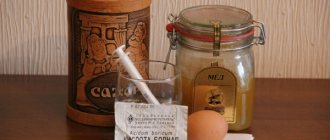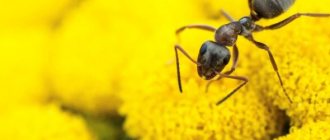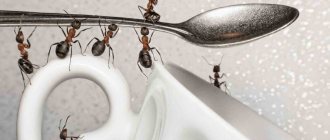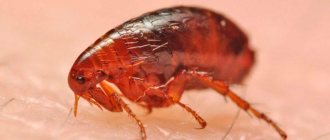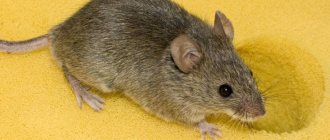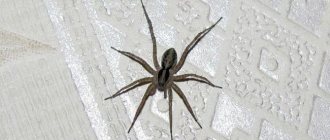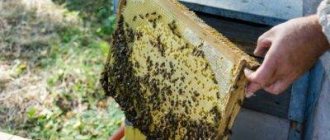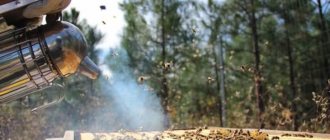Attic beekeeping
Attic beekeeping is considered a type of pavilion keeping insects. In this option, no additional fencing of the apiary is required, and there is no need to be afraid that the bees will bite random strangers.
Is it possible to equip a hive in the attic of a residential building?
You should not think that setting up an apiary under the roof of a house is only worth it if there are no more suitable places. The upper location of the hives has a number of other advantages, which we will consider in more detail below. For attic storage, compact twelve-frame Dadan structures consisting of two buildings, with a hinged rear panel, are most suitable. Ruta hives, installed in several levels, are also good in such situations.
An apiary can not only be placed in the attic under the roof; in certain situations, this is the most suitable place. But it is necessary to provide the insects with absolute peace, and this is quite difficult to do in a noisy house.
Advantages of the method
Advantages of keeping hives in the attic:
- apiary productivity increases;
- isolation from people and animals;
- working with insects does not depend on weather conditions and time of day;
- there are no sharp temperature fluctuations, high-quality ventilation and additional insulation in the cold season;
- the service life of the hives increases;
- possibility of using electric heaters;
- It is permissible to make hives from plywood.
Hive placement rules
Before setting up an apiary in the attic, it is worth familiarizing yourself with the basic rules and principles of pavilion placement. To prevent aggression and restless reactions of insects, they should equip a landing zone. Insects collecting nectar and carrying it to the hive should not be disturbed or disturbed by anything along the way.
It’s good if this is one of the walls of the barn, which has almost no movement of random and strangers. An excellent solution would be a small front garden, located on the south or east side, fenced with green spaces.
It is recommended to insulate the attic. The simplest option: lay polystyrene foam or a layer of sawdust mixed with lime (20:1) on the roofing material. Instead of roofing felt, you can use more modern vapor and waterproofing. Additional external insulation is made from materials that allow steam to pass through, since there should not be a high level of humidity inside the room.
A small space is allocated in the attic for storing frames, honey, bee bread, tools, etc. There is no need to insulate it, but lighting and ventilation are necessary.
If there are up to ten hives in the attic apiary, they can all be turned with their facades in one direction. It is better if it is east or south. When the number of hives is larger, they are installed facing both indicated cardinal directions.
Holes in the walls from the inside along the contour are lined with 20 x 25 mm slats. This makes it easier to align the hive entrances with the holes in the walls.
Attic arrangement and sound insulation
An important element in arranging an attic apiary is the presence of high-quality vibration and sound insulation. To prevent insects from becoming restless, they should be protected as much as possible from any signs of life below. You can do it like this:
- Cover the attic floor with a mixture of sawdust and lime (20:1) with a layer of 160-200 mm.
- Place a shield made of boards at least 5 mm thick on the pillow. Lay it so that it does not touch the walls and ceiling.
- Cover a wooden board with warm linoleum, on which to install the hives.
In winter, peace and quiet are of particular importance for insects. At this time, bees should not be disturbed by any extraneous sound; the beekeeper’s task is to create such conditions.
Keep in mind! One of the mandatory activities carried out in the apiary is working with a smoker. Do not forget to equip a window for smoke exit; it is better to make it on the same wall where the entrances are located.
Lighting and ventilation
It is more advisable to make the lighting combined - ordinary electric from LED or fluorescent lamps, and windows. As soon as the hives open, the bees usually head straight to the lamps. When there are a lot of bees, turn off the light for a couple of minutes and then open the window.
When working with insects, turn on the lights or open the windows located next to the hives. Light bulbs are placed higher than windows to make it easier for bees to leave the attic.
Keep in mind! 3-4 multi-hull hives are equipped with lighting from a pair of electric lamps and one window with dimensions of approximately 30 x 80 cm.
Which is better: a cowshed or a barn?
If there is a choice between a barn and a barn in which pets are not kept, it is naturally better to give preference to the second option. Neither a cattle barn nor a poultry house are suitable for placing an apiary.
Firstly, such a neighborhood does not meet sanitary standards. Secondly, bees often react aggressively not only to living creatures that create disturbance, but also to the characteristic odors that accompany them.
Keep in mind! Veterinary standards prohibit locating an apiary at a distance closer than 1 km from livestock or poultry farms. Otherwise, the risk of outbreaks of infectious diseases increases.
Keeping bees in the attic allows you to easily and effectively organize the wintering of insects. The beekeeper does not need to worry about additional insulation of the hives or bringing them into the omshanik for the winter. Insects also respond well to such placement, provided that they are not disturbed by extraneous noises and odors.
Where can bees settle?
Bees live in swarms. As soon as a second queen appears in a formed family, she heads a certain number of worker insects and drones and moves to a new place of residence: in a hollow tree, in a crevice, in the ground, but also in a window frame or under a roof.
Under the roof
The roof of the building has a complex structure. A bee's nest can be placed in any cavity of suitable size and is sometimes hidden in such a way that it takes a lot of effort to detect and neutralize it.
Typical places are:
- in the attic, that is, inside the building. Insects can fly in through the dormer window, an opening formed by a peeling roof;
- outside, right under the overhanging roof. Bees build a nest in the rafters, or more precisely, in the gap between the rafter leg and the roofing material. It is easier to get rid of bees because the nest is in plain sight;
- the most difficult option is that the hive is located between the sheathing and the casing, in the resulting cavity. Finding it is not easy, and disarming it is even more difficult;
- bees live in brick chimneys. To drive them out, you just need to heat the stove.
Important! A bee's nest is often confused with a wasp's nest or with the habitat of hoverflies. Before you do anything, you need to establish what kind of insects live under the roof.
In the wall of the house
The walls of the building provide a convenient basis for forming a nest. Most often, bees settle in wooden buildings, however, brick houses are also suitable for them. Typical places are:
- on any section of a wooden wall - insects gnaw holes in the wood and create entire labyrinths under the surface;
- in wooden window frames – the window design presents a convenient structure due to right angles and cracks. And in the frame the bees easily make moves;
- On brick walls, insects build their habitat using architectural elements: arches, half-columns, door frames, balconies.
Getting rid of bees in the walls and roof of a wooden house requires non-trivial solutions. Experts recommend luring out the insects first, since it is very difficult to destroy their nest hidden deep in the timber.
In the garden
Wild bees are more likely to settle in the garden, as this option is closer to their natural habitat. The most likely places are:
- a hollow tree is the most obvious solution;
- trunk crevices, depressions formed by the interweaving of branches and deformation of the trunk. In this case, part of the hive is in the tree, and part is built on;
- hole in the ground - such a nest is built by earth bees.
Important! Insects create their habitat near a permanent source of water. That's why they move to garden plots.
How to make an urgent flight of bees in the attic?
If, during a regular inspection, you notice traces of diarrhea in the hive and hear excessive buzzing of insects, you need to organize an extraordinary flight for them. Most likely, the working women simply will not live to see spring.
To prevent this from happening, the temperature in the attic rises to 20-22 °C. With this heating, the bees under the roof fly out of the hive and defecate. Then the temperature gradually decreases. To make insects fly out of their homes more actively, you can hang jars of syrup on the ceiling, after tying them with gauze.
Harm and benefit
Before poisoning bees, scaring them away or moving them to another place, it is worth assessing the benefits and damage that insects can cause. Both wild and domestic honey bees are the main pollinators of garden and vegetable crops. Their presence is a guarantee of a good harvest.
However, too many insects or poor placement of the nest, such as inside a wooden wall, pose a danger. Domestic bees rarely attack first; wild bees are much more aggressive and their poison is stronger. If a swarm lives right in a window frame or in a wall, such a neighborhood poses a threat.
Useful tips
It is not recommended to seal bees in walls because they will find a new way out. Even if a certain number of insects die, they will become a bait for other unpleasant pests.
If the bees are located outside the yard or are bred by neighbors, the only option is a fence 2-3 meters high. The method is expensive, but there will be no more insects in the yard. Experienced beekeepers note that insects do not like the smell of lavender, so they advise planting it in the yard.
Other useful tips:
- You should not plant plants with a strong, attractive aroma nearby.
- Regular tree pruning is important to reduce blooms in your yard.
- Even if the bees have left the house, the hive cannot be left. Leftover honey can attract wasps and hornets.
- The bag is taken away, as otherwise it will attract rodents and beetles.
- If bees have settled in a hollow, it is processed and then securely sealed.
There are many types of pests, aggressive or not, and out of ignorance you should not stir up the hive yourself. If a person tries to get rid of an unpleasant neighborhood without experience or proper equipment, bees can bite him. Some summer residents do not touch the hives. Small families are not capable of causing harm, but only pollinate the garden and vegetable garden.
0 0 votes
Article rating
Fighting methods
Getting rid of bees involves 2 main solutions: repelling and destroying. If insects fly from a neighboring area where their hive is located, the simplest means are sufficient. For example, an unpleasant odor causes most bees to fly away from an area. However, the substance must be selected taking into account the “taste” of honey collectors. Such an effective insecticide against pests as birch tar hardly scares bees.
If a nest is found on the site - a mink in a garden bed, a hive in a wooden wall - more drastic methods are used. It is best to lure the bees out of the nest and transport the swarm to the forest. As a last resort, they are destroyed.
Folk remedies
There are many ways to repel or poison insects. Their habits are well known, so it is not difficult to find the most accessible and safe way. You shouldn’t try to destroy them right away: there are many ways to force bees to leave their hive.
Peppermint and clove essential oil
Insects are very sensitive to odors. The simplest folk remedy for getting rid of bees in the country is the essential oil of cloves, mint, and mustard. They can't stand these scents.
Aroma lamps generously seasoned with essential oil are placed along the fence from which insects fly. An alternative option is to place pieces of fabric soaked in an aromatic substance on the fence.
Candles with citronella provide the same effect. Burning candles are placed along the veranda or on the table where the evening is spent. The aroma repels not only bees, but also mosquitoes.
To protect yourself from their attention, just drop a drop of mint or clove essential oil on the bend of your elbow and in the hollow between your collarbones. You can use a repellent containing similar essential oils.
Bags of mothballs
The smell of mothballs also irritates insects. Linen bags are filled with mothballs and hung on the fence, on fruit trees, on the walls. The aroma is so unpleasant to bees that it can force them to leave the hive if they have settled, for example, in the hollow of an apple tree.
Vinegar solution
If honey collectors are interested in the source of water at their summer cottage, then you can get rid of them by setting up water traps. To do this, cut off the top 1/3 of the plastic bottle and insert it with the neck down. The container is filled with a vinegar solution: 15 ml of ordinary essence per 2 liters of water. Traps are hung along the fence on nails.
If you replace vinegar with a 2% salt solution, the bees in such a trap will die. This remedy is resorted to if a neighboring beekeeper refuses to take action: move the hives away from the fence so that the bees fly less into the area.
Basil
The smell of basil repels insects: bees, wasps, mosquitoes. However, only fresh living leaves have this property. To protect yourself from invasion, basil is planted along the fence or around the veranda. The plant is well accepted, but needs abundant watering, and most importantly, solar warmth. Basil will not grow in the shade.
Onion garlic
The pungent smell of plants irritates the human sense of smell. It is intolerable to bees. A bed of garlic or onions, planted along a fence or just in the garden, will repel almost all insects.
Interesting! Feeding bees with onions and garlic in sugar syrup increases immunity and prolongs their life.
Live mint or lemon balm repels insects no worse than essential oil. The plant easily takes root in almost any soil and does not require care, although it prefers sunny areas. The bed is laid out along the fence or next to the house.
Citronella, a lemongrass plant, has the same effect. They grow it more often in pots than in garden beds, and in the summer they take it outside and install it along the veranda.
Lavender
Beautiful unpretentious flowers drive away wasps, bees, and mosquitoes. The plant is not afraid of common pests, so lavender can be planted right under a window or near the veranda. Dried flowers - whole or in sachet form, for example, are not as effective.
Sagebrush
It not only irritates wasps and bees, but can also poison, since the plant sap contains toxic substances. Not everyone likes the specific smell of wormwood, so they try not to plant it near the house. But a few bushes along the fence or near the garden will force honey collectors to fly around the dacha plot.
Citrus juice
The smell of lemon and orange is unbearable for honey collectors. Citrus juice is used to wipe wooden parts: window frames, doors or even walls. If a swarm has settled inside the beam, lemon juice is dripped directly into the bee passages.
Dried orange or lemon peels will help repel insects. They are laid out in living quarters, on the veranda or in places where bees and wasps are spotted.
How to get rid of wild bees
If wild insects have settled in the wall of the house, there are 5 ways to remove them yourself:
- Bees do not like loud sounds and vibrations, so this method can be used. There is no need for special devices; you can play loud music near the wall so that the player creates vibration. It's good if there is a subwoofer in the house.
- Petrol. You need to find holes in the house and pour kerosene or gasoline into them. Insects do not like the strong smell and will leave. But this method should be approached responsibly, since gasoline and kerosene are highly flammable, and pests may not be the worst problem.
- Pesticides. They are poured into bee passages. Such drugs are sold in specialized stores. If it is not possible to purchase poison, there is a popular method: boric acid is poured into the holes, which is a relatively cheap and effective drug.
- Another non-standard method is an aerosol carburetor cleaner. The aerosol kills insects and prevents the appearance of new ones.
- Pour 5 to 10 liters of boiling water into the holes. The bees will die, but there is no guarantee that they will not repopulate.
Important! It is strictly forbidden to isolate pests using concrete mortar. The bees will quickly find their bearings, begin to make further holes and appear inside the house. By this point they can become very angry.
Prevention of occurrence
It is unwise to completely get rid of bees: they are the main pollinators of plants. To prevent them from entering the house or to prevent a re-invasion, perform the following actions:
- wooden walls, window frames and doors are painted, as the smell of paint repels bees;
- spray verandas and windows, as well as living quarters with sprays or wipe the surface with mint decoctions and tinctures;
- in places where insects are spotted, lay out the peels of lemon, orange, and tangerine;
- cracks in window frames and doors are sealed with sealant;
- Plants that repel insects are planted around the house or along the fence.
